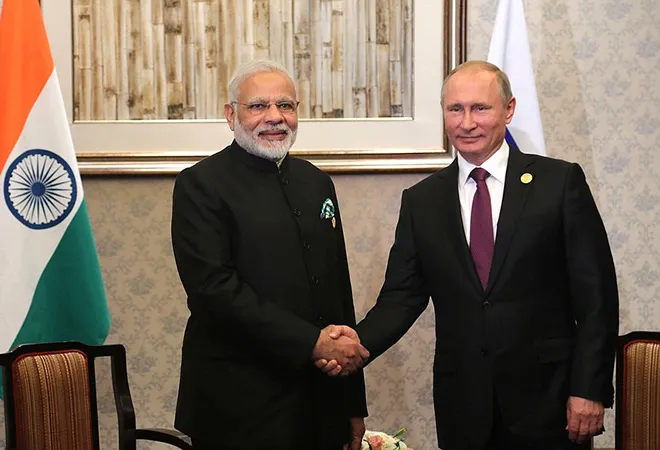-
CENTRES
Progammes & Centres
Location

Headline grabbing big-ticket defence deals make news whenever Indian PM Narendra Modi and Russian President Vladimir Putin meet for an annual summit relegating other important aspects to the background. A weak economic base is a problematic part of India Russia engagement which requires attention for long-term sustenance of the strategic partnership. A bilateral relationship in international arena is robust when it is supported by strong geo-political and geo-economic foundations. India shared strong ties with former Soviet Union as it was India’s biggest defence and trade partner during the Cold War.
After 1991, the US, China, the United Arab Emirates (UAE) and Southeast Asian countries have emerged as India’s big trade partners while India and Russia have failed to find a sustainable economic logic to their ties, although they continue to have geopolitical convergence with minor differences. In a rapidly changing world where the clamour against globalization is growing, weak commercial ties could undermine durability of this relationship in the long-run which is dominated by defence trade. The size of Indian economy is projected to substantially grow in next decade and to inject fresh momentum in India-Russia ties, the issues impacting their trade should be addressed else Moscow could miss out on India’s economic boom.
Sample some facts. In 2017, the trade between the two countries was around $ 10 billion, India’s least with a P-5 country. In comparison, India-US trade is over $ 100 billion. Both countries are absent in their respective list of top 15 trading partners. They account for a meagre 1% of each other’s total trade volume. A strategic bilateral relationship between major powers cannot be sustained without a strong economic content and it is the economics that brings strategic character to the relationship in most cases. The good political ties between India and Russia are not reflected in their economic links, unlike India-US relations which are backed by strong geopolitical and geoeconomic foundations. Even with a country like China that is India’s foremost security concern, New Delhi has more to trade than with a ‘time-tested’ friend like Russia. The Western sanctions have made Russia dependent on China which has strategic implications for India and expansion of India Russia trade could lessen Moscow’s dependence on Beijing to an extent.
There are a number of issues that hinder India-Russia trade – connectivity issues, distance, weak banking links, cumbersome regulations on both sides and Russia’s restrictive visa regime. Ever since India has privatised its economy, the US, Europe and Asia Pacific contribute more than Russia towards what India needs like foreign direct investment, managerial expertise and services. On the other hand, arms and energy sales are two main features of Russia’s export basket limiting Moscow’s contribution to Indian economy. Russian firms import goods from China or Europe as transport takes one or two weeks compared to 40-50 days from India. This could change as the two sides are working to solve the connectivity issue mainly through the International North South Transport Corridor (INSTC) that is 40 per cent shorter and 30 per cent cheaper than the present Suez route. There is a need to expedite the free trade negotiations between India and Russia steered Eurasian Economic Union (EEU). Once finalized, the FTA with EEU aided by INSTC could increase India-EEU trade from $9 billion to anything between $37-62 billion. Indian policymakers are also looking for the feasibility of Chennai-Vladivostok sea route that could allow India to access Russia’s Far East, a relatively under developed region that lacks manpower.
There is a possibility that INSTC could help in connecting Far East to Indian Ocean. INSTC passes through Aktau on Kazakh side of the Caspian Sea. One branch of the Trans-Siberian railway from Omsk oblast could be connected to Aktau in Kazakhstan. Such a possibility is not difficult as Aktau is already well connected by road and rail network. Hence, INSTC would give Far East an outlet in southern direction. Indian labor is known to be efficient and hence can play a role in development of the region. Even Indian professionals like doctors, engineers and teachers too could go and help in development of Russia’s Far East. Presence of Indian manpower will also help in balancing Russian concerns over Chinese migration into the region. India, one of the largest importers of timber can also import timber from Far East as the region has abundant timber resources.
There is trade imbalance in favour of Russia as areas like defence, energy and nuclear dominate the trade basket. The areas of India’s strength like IT, pharma and health should figure more prominently in India Russia trade basket to make the commercial ties balanced. The Western sanctions on Russia have opened areas like agriculture and dairy products for India. At a time US President Donald Trump’s shadow lurks over H1B visas, Russia should consider opening its IT market to Indian specialists. The two countries can work together in other regions as well. Post-India’s membership in SCO, there is ample room for India and Russia to work together in Eurasia to ensure balance of power is restored to avoid Chinese dominance. India should encourage its private sector companies to work with Russian companies in Central Asia in untapped sectors like IT and renewable energy. Since Russia has close relations with Iran, India should explore the possibility of Russian involvement in Chabahar port which will provide Afghanistan and Central Asia access to sea. India and Russia should also try to align their respective Look East policies which focus on South East Asia and Vietnam and Japan are two key countries in this regard. Indian companies investing in Arctic oilfields could supply oil to Japan through the Northern Sea Route while defense and energy cooperation could be the focus between India, Russia and Vietnam.
Both countries would do well to encourage the role of private sector and enhance banking links as well. In times where Trump is interested in deglobalization while China is promoting Globalization 2.0 with Chinese characteristics, it makes sense for India and Russia to increase trade in order to hedge against disruptive forces.
Dr Raj Kumar Sharma is an Academic Associate at the Faculty of Political Science, IGNOU, New Delhi
The views expressed above belong to the author(s). ORF research and analyses now available on Telegram! Click here to access our curated content — blogs, longforms and interviews.

Dr Raj Kumar Sharma is a Visiting Fellow at United Service Institution of India New Delhi. Prior to it he was Maharishi Kanad Post-Doc Fellow ...
Read More +